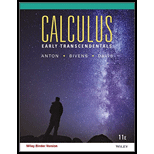
(a) Use Formula
(b) Use a CAS to evaluate the integral and differentiate the resulting function.
(c) Use the simplification command of the CAS, if necessary, to confirm that the answers in parts (a) and (b) are the same.
Want to see the full answer?
Check out a sample textbook solution
Chapter 5 Solutions
Calculus Early Transcendentals, Binder Ready Version
Additional Math Textbook Solutions
University Calculus: Early Transcendentals (4th Edition)
Using and Understanding Mathematics: A Quantitative Reasoning Approach (6th Edition)
Thinking Mathematically (6th Edition)
A Problem Solving Approach To Mathematics For Elementary School Teachers (13th Edition)
Calculus for Business, Economics, Life Sciences, and Social Sciences (14th Edition)
A First Course in Probability (10th Edition)
- rarrow_forwardThe solutions are 1 where x1 x2- ● Question 11 Solve: x 54 Give your answer as an interval. Question 12arrow_forwardA population of deer in Pierce County currently has 1875 deer, but due to urban development, the population is decreasing at a rate of 1.1% a year. a) Assuming this growth rate continues, find the formula for a function f(t) describing this population. b) In how many years will the population reach 1300? Do the problems on your own paper, show all your work, and submit your scanned work below. Choose File No file chosenarrow_forward
- Question 3 Rewrite 4 = log₂(16) in exponential form. Question 4 症 If log, (6x+3)= 4, then rarrow_forwardQuestion 6 Find the solution of the exponential equation 2t 100(1.07) 2 = 500,000 in terms of logarithms, or correct to four decimal places. t=arrow_forwardQuestion 6 Find the solution of the exponential equation 100(1.07)² = 500, 000 in terms of logarithms, or correct to four decimal places. t = Question 7 Solve the equation.arrow_forward
- Algebra & Trigonometry with Analytic GeometryAlgebraISBN:9781133382119Author:SwokowskiPublisher:Cengage


